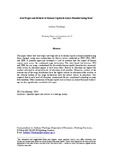| dc.description.abstract | This paper studies how real wages and wage returns to human capital in Kenya manufacturing firms changed, using cross-section data sets from a survey conducted in 1993, 1994, 1995, and 2000. A quantile regression technique is used to examine how the impact of human capital varies across the conditional wage distribution. The study found that between 1993 and 2000, the real wage, standardized for observable human capital characteristics increased, while returns to education appear to have been stable. Returns to education are highest for workers educated to advanced levels of education at all quartiles. Moreover, workers at the extreme top of the wage distribution have the highest returns to education while workers at the extreme bottom of the wage distribution have the lowest returns to education. This suggests that at each level of education, unmeasured factors compliment schooling in wage determination. Other dimensions of human capital such as tenure in current firm and worker's age are also significantly correlated with wages. | en |

